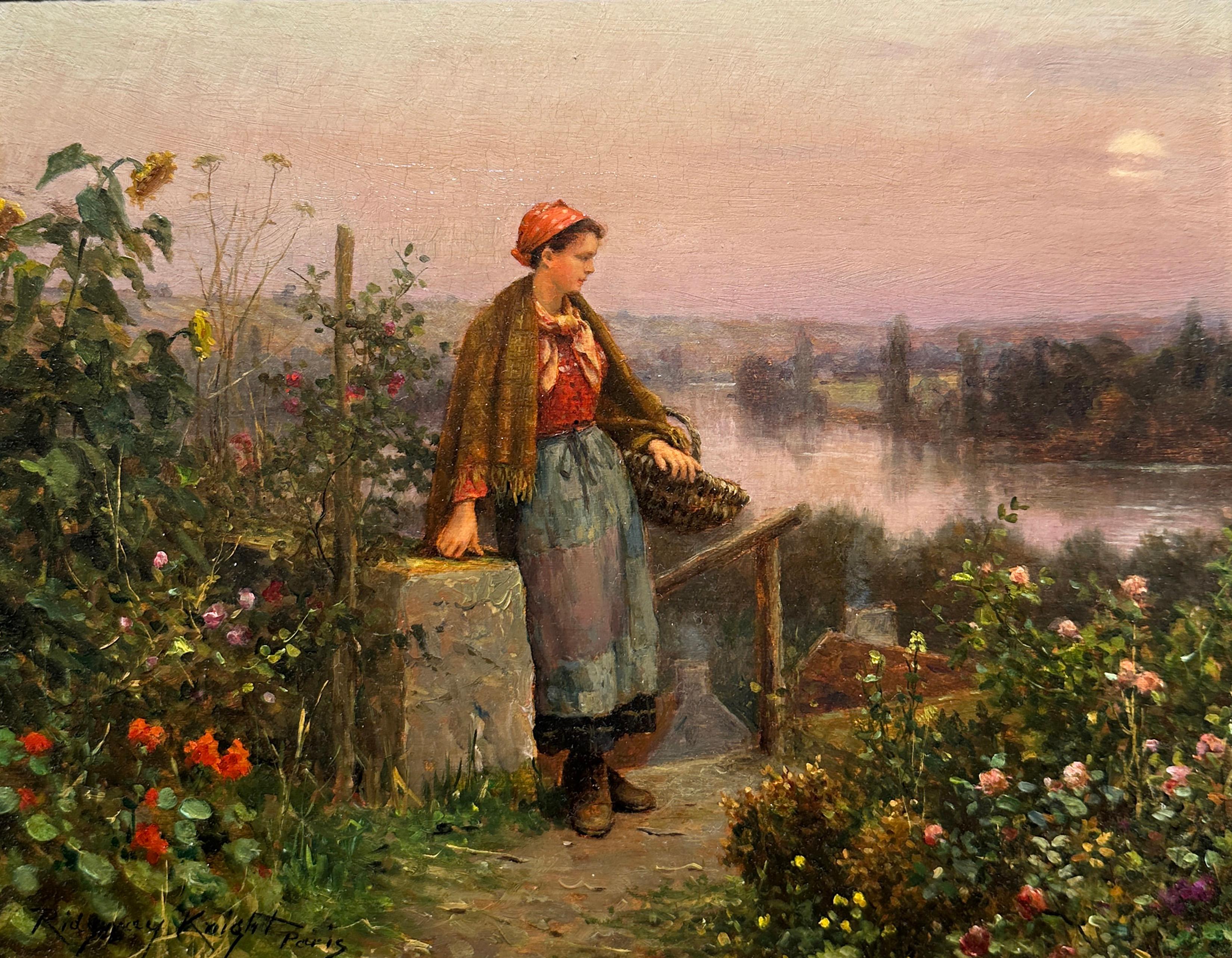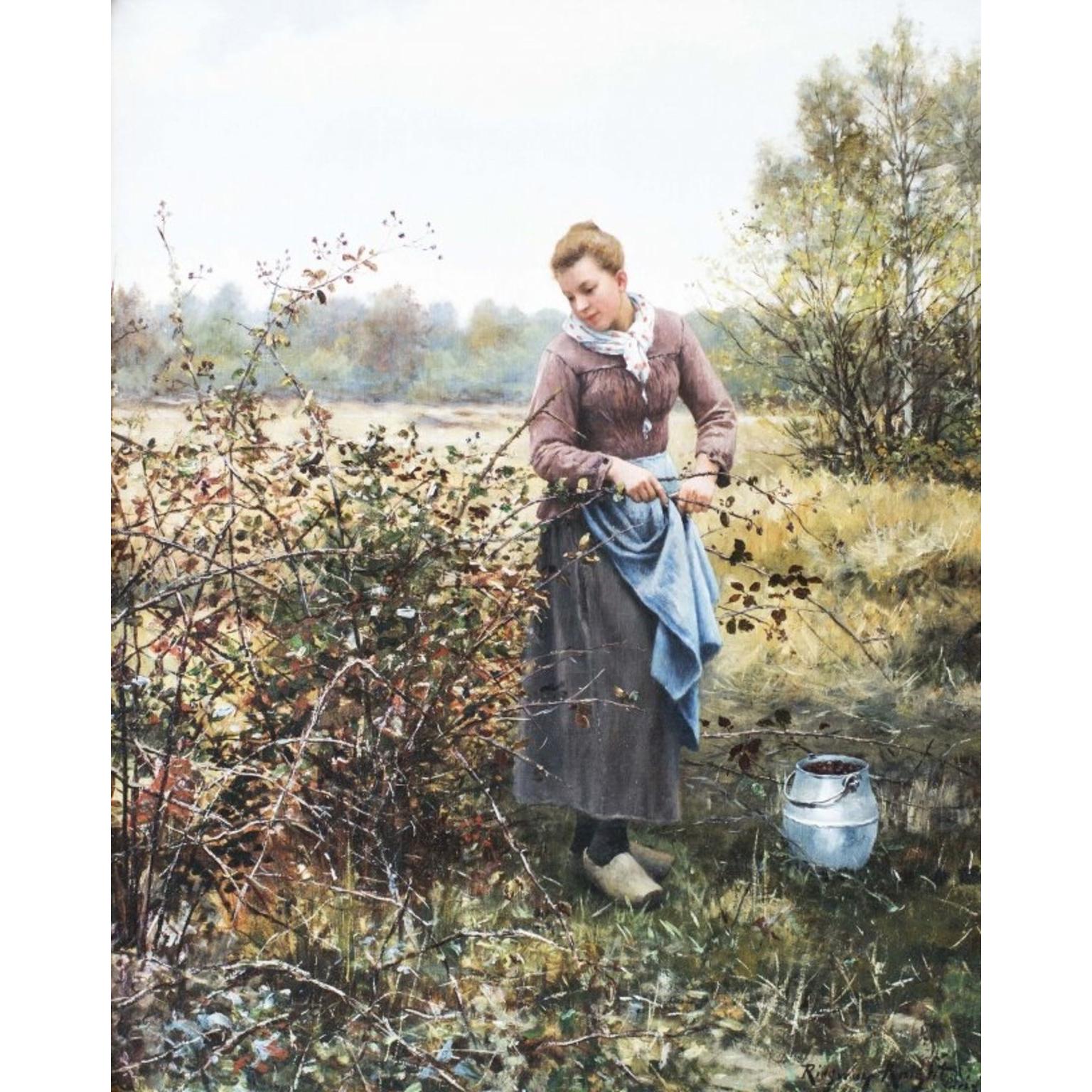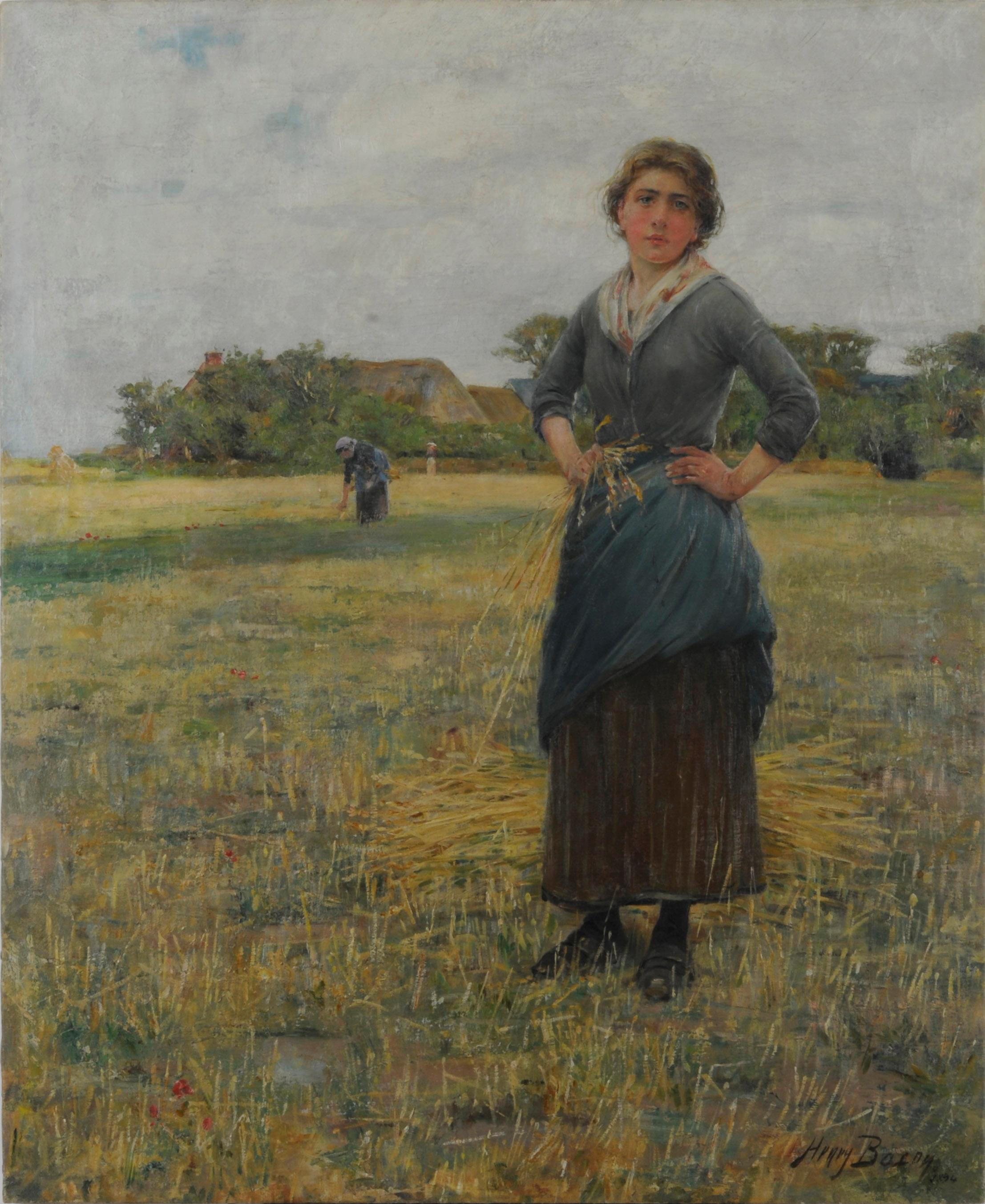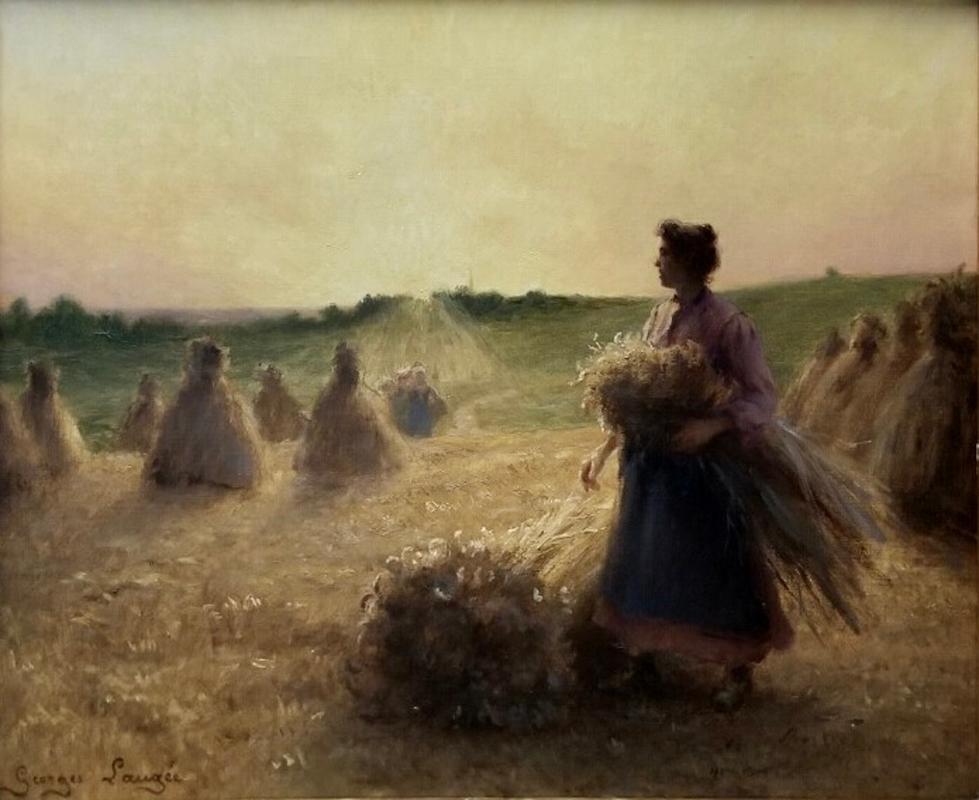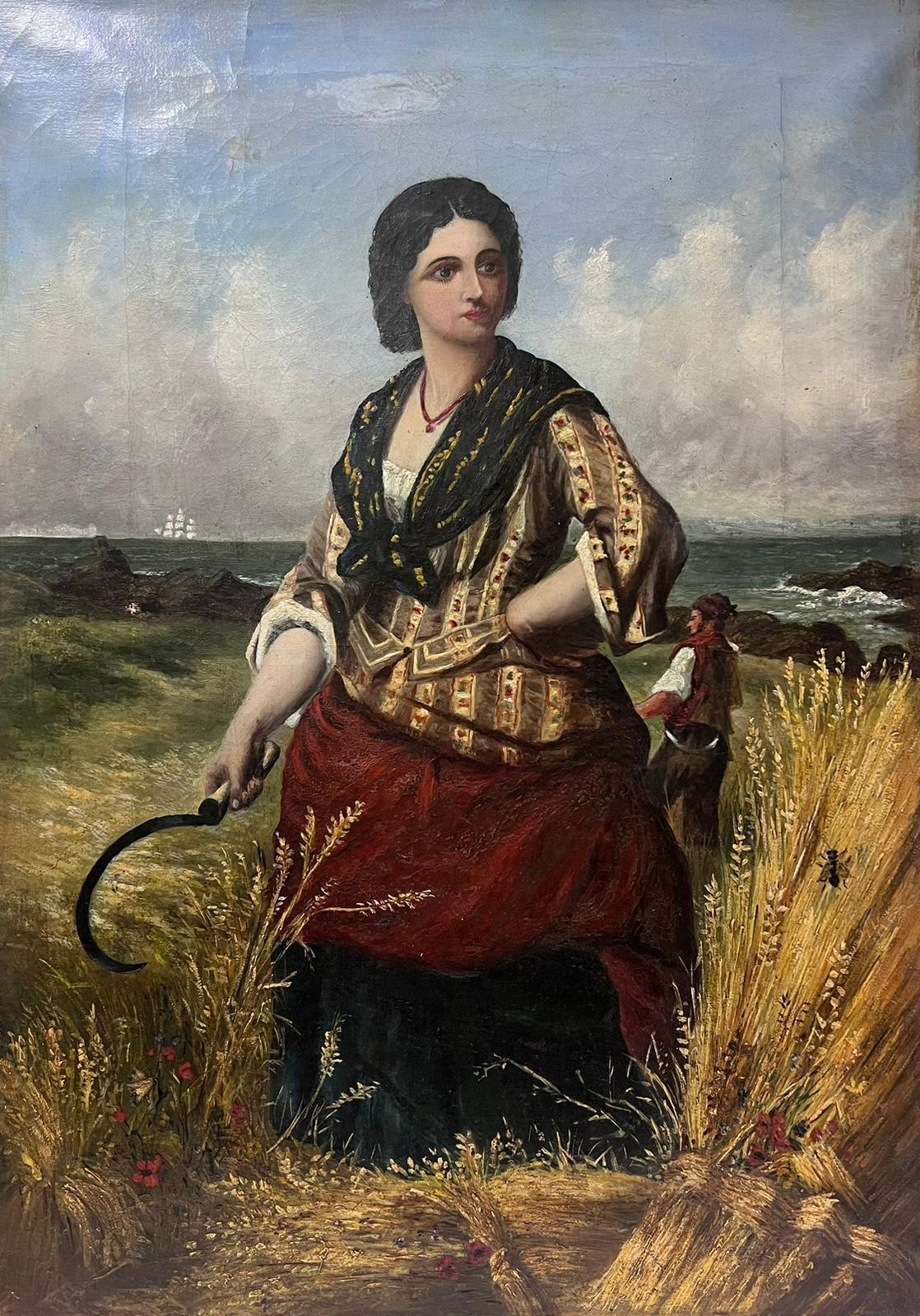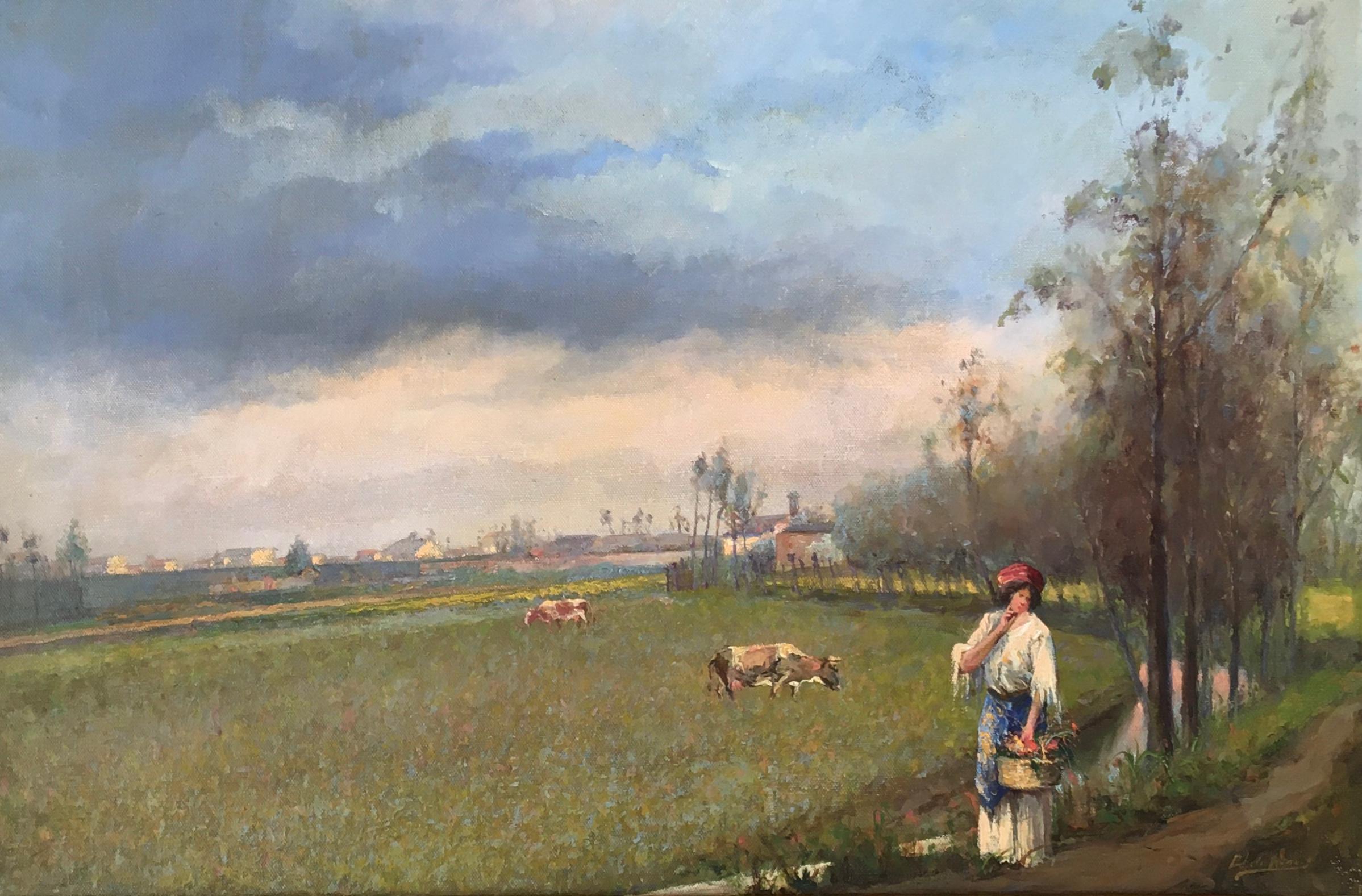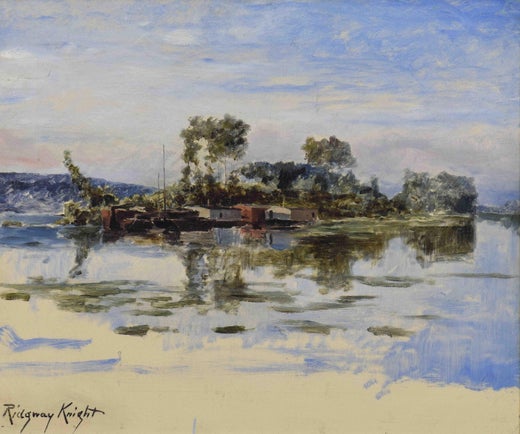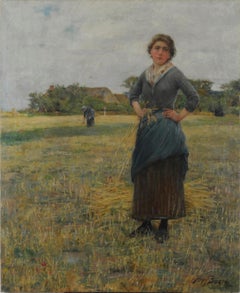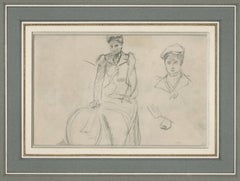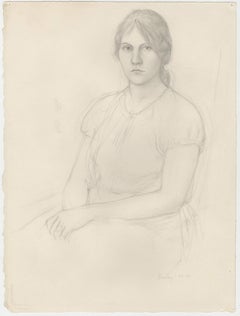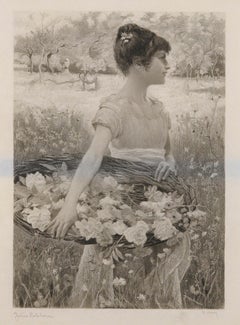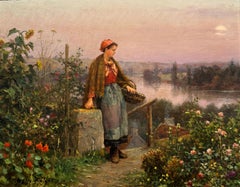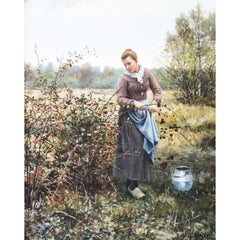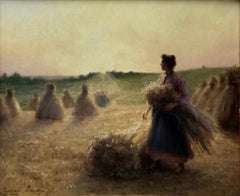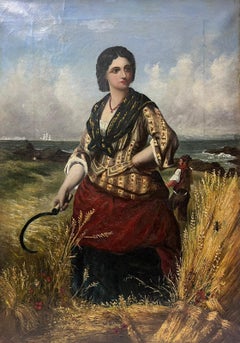Items Similar to Untitled (Woman working in the fields)
Want more images or videos?
Request additional images or videos from the seller
1 of 12
Daniel Ridgway KnightUntitled (Woman working in the fields)1890's
1890's
$4,500
£3,405.80
€3,908.88
CA$6,410.62
A$6,952.47
CHF 3,651.70
MX$84,449.57
NOK 45,695.29
SEK 43,024.66
DKK 29,194.90
About the Item
Untitled (Woman working in the fields)
Graphite on wove paper
Unsigned
Exhibited: Spanierman Galleries, In Praise of Women, Oct. 21-Nov. 20, 2010
Illustrated: Lisa N. Peters, In Praise of Women, Spanierman Galleries (see catalog entry in photos)
Condition: Excellent
Sheet size (sight): 14 1//2 x 10 5/16 inches
Provenance: Spanierman Galleries, New York
The young woman is a known model for Knight. She is depicted in numerous paintings. The striped skirt and wooden shoes she wears also is repeated in Knight's oeuvre.
"Daniel Ridgway Knight was born in Philadelphia to a Quaker family and studied at the Pennsylvania Academy of the Fine Arts from 1858 to 1861, the year he became a founding member of the Philadelphia Sketch Club. He went to Paris and studied at the Ecole des Beaux-Arts from 1861 to 1863 with Charles Gleyre (1808-1874) and Alexandre Cabanel (1823-1889), and attended the Accademia di San Lucca, then in Venice, in 1863. Knight returned to Philadelphia that year, married, and served in the Union Army during the Civil War. He went back to France in 1871 and lived there for the remainder of his long and successful career. He settled in Seine-et-Oise near Poissy to study with the noted academic painter Jean-Louis-Ernest Meissonier (1815-1891) in 1873, and the two artists became close friends. Influenced by his French contemporaries Jules Bastien-Lepage (1848-1884) and Jules- Adolphe-Aimé-Louis Breton (1827-1906), during the middle 1870s Knight began to paint sentimental representations of peasant women in their rural settings. As an early biographer noted, the artist was “for the most part the painter of a single class of models—demure little peasant girls with their wooden shoes and picturesque costumes.” His idealized treatment of such subjects was a far cry from the progressive realist works of Jean-Francois Millet (1814-1875) that stressed the hardships of life among French peasants. Knight’s best known painting Hailing the Ferry (1888, Pennsylvania Academy of the Fine Arts) was an immense success that assured his reputation in both the United States and Europe. Knight exhibited most often at the Paris Salon from 1873 until 1921. In the United States he exhibited at the Pennsylvania Academy twelve times between 1858 and 1910, the National Academy of Design in New York from 1870 to 1878, and intermittently at the Brooklyn Art Association. He opened a studio outside Paris in Rolleboise-par-Bonniers in 1896, and selected subjects from the surrounding countryside and local people. Knight won many professional distinctions throughout his long career, and was made a chevalier of the Legion of Honor in 1889 and a knight of St. Michael of Bavaria in 1892. Knight worked as a pictorial propagandist for the French government during World War I. He died in Rolleboise-par-Bonniers."
Courtesy Schwartz Gallery
- Creator:Daniel Ridgway Knight (1839 - 1924)
- Creation Year:1890's
- Dimensions:Height: 14.5 in (36.83 cm)Width: 10.32 in (26.22 cm)
- Medium:
- Movement & Style:
- Period:
- Condition:
- Gallery Location:Fairlawn, OH
- Reference Number:Seller: FA117821stDibs: LU14015623212
Daniel Ridgway Knight
Daniel Ridgway Knight was an American artist born in Chambersburg, Pennsylvania. Knight was a pupil at the École des Beaux-Arts, Paris, under Gleyre and later worked in the private studio of Meissonier. After 1872, he lived in France, having a house and studio at Poissy on the Seine.
About the Seller
5.0
Recognized Seller
These prestigious sellers are industry leaders and represent the highest echelon for item quality and design.
Platinum Seller
Premium sellers with a 4.7+ rating and 24-hour response times
Established in 1978
1stDibs seller since 2013
815 sales on 1stDibs
Typical response time: <1 hour
Associations
International Fine Print Dealers Association
- ShippingRetrieving quote...Shipping from: Fairlawn, OH
- Return Policy
Authenticity Guarantee
In the unlikely event there’s an issue with an item’s authenticity, contact us within 1 year for a full refund. DetailsMoney-Back Guarantee
If your item is not as described, is damaged in transit, or does not arrive, contact us within 7 days for a full refund. Details24-Hour Cancellation
You have a 24-hour grace period in which to reconsider your purchase, with no questions asked.Vetted Professional Sellers
Our world-class sellers must adhere to strict standards for service and quality, maintaining the integrity of our listings.Price-Match Guarantee
If you find that a seller listed the same item for a lower price elsewhere, we’ll match it.Trusted Global Delivery
Our best-in-class carrier network provides specialized shipping options worldwide, including custom delivery.More From This Seller
View AllWoman in a Field
By Henry Bacon
Located in Fairlawn, OH
Woman in a Field (title unknown)
Oil on canvas, 1894
Signed and dated 1894, lower right corner
Unframed
A major exhibition work by this American Expatriate painter. Further research ...
Category
1890s Barbizon School Figurative Paintings
Materials
Oil
Woman with Bicycle: Two Views
By Frank Duveneck
Located in Fairlawn, OH
Woman with Bicycle: Two Views
Graphite on paper, c. 1890
Unsigned
Graphite study of standing female nude verso
Provenance:
Rookwood Pottery Factory Collection, Cincinnati
Spanierman Gallery, New York (label)
Drawings from the sketchbook are in the collections of the Munson Williams Proctor Institute in Utica, New York and the Picker Art Gallery, Colgate University, Hamilton, New York.
A sister drawing from the same sketchbook was sold at Cowman’s Auction, Cincinnati, October 6, 2018. Accompanied by a letter from the Spanierman Gallery, dated 1997, stating that the drawing is from a sketchbook that was held in the Rookwood Factory Collection.
Sister drawing provenance: Provenance: Terry DeLapp...
Category
1890s American Realist Figurative Drawings and Watercolors
Materials
Graphite
Untitled (Seated Young Woman)
Located in Fairlawn, OH
Untitled (Seated Young Woman)
Graphite on Veritable Papier d'Arches wove paper, 1970
Signed and dated lower right (see photo)
Condition: Excellent
Image/sheet size: 15 x 11 1/4 inch...
Category
1970s American Realist Figurative Drawings and Watercolors
Materials
Graphite
Connais-tu le Pays (Primavera) apres J. Rolshoven (Do you Know the Country)
By Theophile Narcisse Chauvel
Located in Fairlawn, OH
Connais-tu le Pays (Primavera) apres J. Rolshoven
(Do you Know the Country -Spring)
Etching, 1889
Signed "Julius Rolshoven" in pencil...
Category
1880s Barbizon School Figurative Prints
Materials
Etching
Preliminary Study for the painting Rose and Gold, 1913
By William McGregor Paxton
Located in Fairlawn, OH
Preliminary Study for the painting Rose and Gold, 1913
Graphite on paper, 1913
Signed in pencil lower left (see photo)
Titlted "Lizzy Young" in pencil upper left (see photo)
Lizzy was a modle that Paxton depicts numerous times.
The painting that this drawing is related to, is illustrated in Lee & Krause, William McGregor Paxton, 1869-1941, Plate 32, text on page 132. The painting was formerly in the collection of Victor Spark and the Honorable Paul Buchanan. It is currently in a Texas Collection.
Provenance: Private Collection, Florida
William McGregor Paxton (June 22, 1869 – 1941) was an American painter and instructor who embraced the Boston School paradigm and was a co-founder of The Guild of Boston Artists. He taught briefly while a student at Cowles Art School, where he met his wife Elizabeth Okie Paxton, and at the Museum of Fine Arts School in Boston. Paxton is known for his portraits, including those of two presidents—Grover Cleveland and Calvin Coolidge—and interior scenes with women, including his wife. His works are in many museums in the United States.
Early life
He was born on June 22, 1869, in Baltimore to James and Rose Doherty Paxton. William's father moved the Paxton family and established a catering business in Newton Corner, Massachusetts, in the mid-1870s.
Education
Paxton attended Cowles Art School on a scholarship he attained at the age of 18. He studied with Dennis Miller Bunker...
Category
1910s American Impressionist Figurative Drawings and Watercolors
Materials
Graphite
Brittany Landscape with Figure
By Louis Oscar Griffith
Located in Fairlawn, OH
Brittany Landscape with Figure
Etching & color aquatint, c. 1920
Signed lower right (see photo)
Numbered lower left: "No. 21" (see photo)
An early color etching by the artist, based ...
Category
1920s American Impressionist Landscape Prints
Materials
Aquatint
You May Also Like
A Thoughtful Moment
By Daniel Ridgway Knight
Located in Missouri, MO
Daniel Ridgway Knight
"A Thoughtful Moment"
Oil on Panel
Signed Lower Left "Ridgway Knight, Paris"
Framed Size: 12.5 x 14.5 inches
Site Size: 8.5 x 11.5 inches
Daniel Ridgway Knigh...
Category
Late 19th Century Abstract Impressionist Paintings
Materials
Oil, Panel
Price Upon Request
"Picking Berries" by Daniel Ridgway Knight, Signed Ridgway Knight
By Daniel Ridgway Knight
Located in West Palm Beach, FL
Daniel Ridgway Knight
(American, 1839-1924)
Untitled "AUTUMN HARVEST"
Signed Ridgway Knight (lower right)
Oil on canvas.
Provenance:
Schillay & Rehs, Inc., New York City, 19...
Category
Early 20th Century Paintings
Materials
Canvas
Georges Laugée "The Gleaners" French Peasant Woman Working in Field oil/canvas
Located in Rancho Santa Fe, CA
Georges Laugée was a painter known for portrait and peasant figures in landscape painting. He was influenced by William Bouguereau and Jules Breton, gracing the figures in his compos...
Category
Late 19th Century French School Figurative Paintings
Materials
Canvas, Oil
Woman in Harvest Fields Next to Coastal Seascape Victorian Oil Painting canvas
Located in Cirencester, Gloucestershire
The Harvest Workers
English School, 19th century
oil on canvas, unframed
canvas: 24 x 16.5 inches
provenance: from a collection in England
condition: very good and sound condition
Category
19th Century Victorian Portrait Paintings
Materials
Oil, Canvas
Woman with Basket of Wildflowers
Located in Genève, GE
Work on canvas
Golden wooden frame
63 x 88 x 3.5 cm
Category
Early 20th Century French School Landscape Paintings
Materials
Oil
Woman - Original Drawing by L.E. Adan - Early 20th Century
Located in Roma, IT
Woman is an original drawing in ink realized in the early 20th Century by Louis Emile Adan (1839-1937).
Good Conditions.
The artwork is depicted thr...
Category
Early 20th Century Modern Figurative Drawings and Watercolors
Materials
Ink, Watercolor
